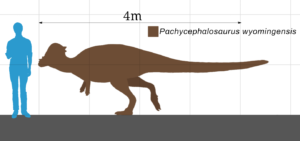Aardonyx Guide:
Aardonyx was an early dinosaur that lived in South Africa about 200 million years ago.
Aardonyx was an early dinosaur that lived in South Africa about 200 million years ago.

The dinosaurs known for their hard head were a type of dinosaur known scientifically as Pachycephalosaurs (also known as the thick headed lizard). This bony dome dinosaur is globally recognized for its signature thick-boned skulls. They roamed North America during the Late Cretaceous period (145 to 66 million years ago). Also known as “The real hero of ‘Jurassic World: Fallen Kingdom’” was the headbutting dinosaur known as Stiggy.
The first Pachycephalosaurus fossil was found by Donald Baird in 1859. An early fossil collector in the Western North America he collected a bone fragment in the vicinity of the head of the Missouri River. This is what is now known to be the Lance Formation in southeastern Montana. Even though it was discovered so long ago, it wasn’t until 1942 when the dinosaur was given its official name, which translates to “thick headed lizard”.
Very few fossils have been found; however, out of the few found, a complete fossil skull, skull fragments, hind legs, various skull shapes, and skull remains have all been recovered by archaeologists. Juvenile skulls can look strikingly different from their adult forms. Particularly if it’s not a complete skull as this can make it hard to tell whether a fossil fragment represents a newly identified species, a species closely related, or is a juvenile version of an existing species.

Pachycephalosaurus grew to be about 16 feet (5 meters) long, they were bipedal with strong hind limbs and very short forelimbs. The height of the Pachycepholosaurs could reach between 5ft-7ft tall. This is based on the reconstruction of fossils from Montana, South Dakota, and Western U.S. The average weight of an adult dinosaur was 990 pounds (450 kg).
Their neck was thick and short. They did not have a long tail, as it was short to help balance better when on their hind legs. Although its size was relatively small compared to other dinos, Pachycephalosaurus was a feisty creature known to butt heads with their heavy skull dome against rivals during mating season.

Why did Pachycephalosaurus have such a thick skull? Some scientists think the purpose of having such a thick skull may have protected their tiny brain while head butting other dinosaurs for defense against predators, while many other scientists say their dome heads also helped attract mates.
They were characterized by their thick skulls and bony plates on their heads, which served as protection against predators or rivals during mating season. Studies show that the dinosaur’s brain was only the size of a walnut, so the thick skull may have served as a means of protection.
The Pachycephalosaurus diet is believed to be mostly plant-based being herbivores that lived during the Late Cretaceous period. However, scientists believe they might have actually eaten both plants and meat (omnivorous) due to the shape of their teeth.
Whether they were herbivorous or omnivorous, this head butting dinosaur with hard head and bony plates was a unique dinosaur that captured the imaginations of many throughout history.
Pachycepholosaurs were also known to be one of the most aggressive and territorial dinosaurs. When two Pachycephalosaurus met, they would lower their heads and charge at each other. The dinosaur with the harder head would usually win the battle.

Stygimoloch is from the genus pachycephalosaurus family. It was distinguished from other pachycephalosaurs by the row of spikes on the back of its head, behind the dome characteristic of the family. The meaning of the name Stygimoloch means a demon from the river Styx (yes, that river of styx of greek mythology).
Jack Horner presented evidence back in 2009 (and various others since) that suggests the Stygimoloch might actually be the juvenile form of Pachycephalosaurus.
The Stygimoloch specimens were recovered from the Hell Creek Formation, Lance Formation, and Ferris Formation. Examining their fossil distribution helps to conclude that they lived around present day Montana in the United States.
Did you know that this dinosaur actually had a third eyelid?
The Pachycephalosaurus third eyelid was called the nictitating membrane. This membrane was clear and protected the dinosaur’s eyes while still allowing it to see.